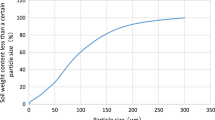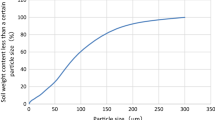Abstract
Cemented gangue backfill technology is beneficial to the reuse of solid waste and sustainable economic development. However, mine water has a great impact on the strength and deformation of cemented gangue backfill (CGB). In this study, the CGB specimens under load were placed in simulated acid mine water (H2SO4 solution). The changes in deformation, resistivity, and ultrasonic pulse velocity (UPV) of CGB were monitored. On the 360th day, the stress–strain curve and acoustic emission (AE) energy of the specimen during loading were recorded. The degradation mechanism of CGB was discussed by scanning electron microscope (SEM) and X-ray diffraction (XRD). The results showed that the deformation of CGB increased with time. The effect of H2SO4 solution concentration on the deformation was different in the early and late stages. Applying an 80% stress-strength ratio (SSR) reduced the strength and increased the deformation. The UPV and resistivity had different characteristics at different corrosion ages, which could be used for long-term stability monitoring of CGB. The CGB showed the strongest AE energy characteristics near the peak stress. The AE energy decreased with the increase of pH value in the pore compaction stage, and the AE activity of the CGB under 80% SSR was much greater than that of the CGB under 40% SSR. The erosion of the H2SO4 solution on the CGB was inhibited by applying a small load. Excessive load aggravated the erosion deterioration of CGB due to initial plastic damage. The research results can provide a reference for the durability design of CGB.
















Similar content being viewed by others
Data availability
The datasets used and/or analyzed during the current study are available from the corresponding author on reasonable request.
References
Cao S, Xue GL, Yilmaz E (2019) Flexural behavior of fiber reinforced cemented tailings backfill under three-point bending. IEEE Access 7(1):139317–139328. https://doi.org/10.1109/ACCESS.2019.2943479
Chen G, Ye YC, Yao N, Fu FH, Hu NY, Zhang Z (2022) Deformation failure and acoustic emission characteristics of continuous graded waste rock cemented backfill under uniaxial compression. Environ Sci Pollut R 53(29):80109–80122. https://doi.org/10.1007/s11356-022-23394-x
Chopperla KST, Ideker JH (2022) Using electrical resistivity to determine the efficiency of supplementary cementitious materials to prevent alkali-silica reaction in concrete. Cem Concr Comp 125:104282. https://doi.org/10.1016/j.cemconcomp.2021.104282
Dong HZ, Feng GR, Guo YX, Qi TY, Kang LX, Guo XY, Han YL (2013) Pipe transportation characteristics of filling slurry in Xinyang mine. J Min Saf Eng 30(06):880–885. https://doi.org/10.1007/978-0-387-71815-6_20.(inChinese)
Du XJ, Feng GR, Zhang YJ, Wang ZH, Guo YX, Qi TY (2019a) Bearing mechanism and stability monitoring of cemented gangue-fly ash backfill column with stirrups in partial backfill engineering. Eng Struct 188:603–612. https://doi.org/10.1016/j.engstruct.2019.03.061
Du XJ, Feng GR, Qi TY, Guo YX, Zhang YJ, Wang ZH (2019b) Failure characteristics of large unconfined cemented gangue backfill structure in partial backfill mining. Constr Build Mater 194:257–265. https://doi.org/10.1016/j.conbuildmat.2018.11.038
Gao MZ, Xie J, Gao YA, Wang WY, Li C, Yang BG, Liu JJ, Xie HP (2021) Mechanical behavior of coal under different mining rates: a case study from laboratory experiments to field testing. Int J Min Sci Techno 31(5):825–841. https://doi.org/10.1016/j.ijmst.2021.06.007
Gawel K, Wenner S, Edvardsen L (2021) Effect of carbonation on bulk resistivity of cement/carbon nanofiber composites. Constr Build Mater 305:124794. https://doi.org/10.1016/j.conbuildmat.2021.124794
Genoves V, Gosalbez J, Carrion A, Miralles R, Paya J (2017) Ultrasonic broadband signals monitoring of glass-fiber reinforced cement (GRC) bending tests. Cem Concr Compos 80:55–63. https://doi.org/10.1016/j.cemconcomp.2017.02.009
Guo YX, Wang P, Feng GR, Qi TY, Du XJ, Wang ZH, Li QD (2020a) Experimental study on diffusion process of sulfate ion in cemented gangue backfill material. Adv Civ Eng 4:1–14. https://doi.org/10.1155/2020/5846397
Guo YX, Ran HY, Feng GR, Du XJ, Qi TY, Wang ZH (2020b) Effects of curing under step-by-step load on mechanical and deformation properties of cemented gangue backfill column. J Cent South Univ 27(11):3417–3435. https://doi.org/10.1007/s11771-020-4556-y
Guo YX, Zhao YH, Wang SW, Feng GR, Zhang YJ, Ran HY (2021b) Stress-strain-acoustic responses in failure process of coal rock with different height to diameter ratios under uniaxial compression. J Cent South Univ 28(6):1724–1736. https://doi.org/10.1007/s11771-021-4729-3
Guo SJ, Zhang JX, Li M, Zhou N, Song WJ, Wang ZJ, Qi SM (2021) A preliminary study of solid-waste coal gangue based biomineralization as eco-friendly underground backfill material: material preparation and macro-micro analyses. Sci Total Environ 770:145241. https://doi.org/10.1016/j.scitotenv.2021.145241
Guo YX, Ran HY, Feng GR, Du XJ, Zhao YH, Xie WS (2022) Deformation and instability properties of cemented gangue backfill column under step-by-step load in constructional backfill mining. Environ Sci Pollut R 2(29):2325–2341. https://doi.org/10.1007/s11356-021-15638-z
Guo YX, Zhao YH, Feng GR, Ran HY, Zhang YJ (2021a) Study on damage size of cemented gangue backfill body under uniaxial compression. Chin J Rock Mech Eng 40(12):2434−2444. https://doi.org/10.13722/j.cnki.jrme.2021.0527. (in Chinese)
Hou JF, Guo ZP, Li JB, Zhao LJ (2021) Study on triaxial creep test and theoretical model of cemented gangue-fly ash backfill under seepage-stress coupling. Constr Build Mater 273:121722. https://doi.org/10.1016/j.conbuildmat.2020.121722
Irshidat MR, Al-Saleh MH (2020) Repair of heat-damaged RC columns using carbon nanotubes modified CFRP. Mater Struct 50(2):162. https://doi.org/10.1617/s11527-017-1034-6
Kariem H, Kiefer T, Hellmich C, Gaggl W, Steiger-Thirsfeld A, Fussl J (2020) EDX/XRD-based identification of micrometer-sized domains in scanning electron micrographs of fired clay. Mater Struct 53(4):109. https://doi.org/10.1617/s11527-020-01531-7
Kencanawati NN, Iizasa S, Shigeishi M (2013) Fracture process and reliability of concrete made from high grade recycled aggregate using acoustic emission technique under compression. Mater Struct 46(9):1441–1448. https://doi.org/10.1617/s11527-012-9986-z
Li JJ, Yilmaz E, Cao S (2020) Influence of solid content, cement/tailings ratio and curing time on rheology and strength of cemented tailings backfill. Minerals 10(10):922. https://doi.org/10.3390/min10100922
Li BY, Zhang JX, Yan H, Liu HF, Zhu CL (2022) Thermal enhancement of gangue-cemented paste backfill with graphite and silica sand: an experimental investigation. Environ Sci Pollut R 32(29):49050–49058. https://doi.org/10.1007/s11356-022-19305-9
Liu ZB, Liu SY, Cai Y, Fang W (2015) Electrical resistivity characteristics of diesel oil-contaminated kaolin clay and a resistivity-based detection method. Environ Sci Pollut R 11(22):8216–8223. https://doi.org/10.1007/s11356-014-3964-7
Liu JH, Zhao YL, Tan T, Zhang LY, Zhu ST, Xu FY (2022) Evolution and modeling of mine water inflow and hazard characteristics in southern coalfields of China: a case of Meitanba mine. Int J Min Sci Techno 32(3):513–524. https://doi.org/10.1016/j.ijmst.2022.04.001
Meng GH, Zhang JX, Li M, Zhu CL, Zhang Q (2020) Prediction of compression and deformation behaviours of gangue backfill materials under multi-factor coupling effects for strata control and pollution reduction. Environ Sci Pollut R 29(27):36528–36540. https://doi.org/10.1007/s11356-020-09465-x
Miao XX, Wu JY, Wang YM, Ma D, Pu H (2022) Coupled effects of fly ash and calcium formate on strength development of cemented tailings backfill. Environ Sci Pollut R 40(29):59949–59964. https://doi.org/10.1007/s11356-022-20131-2
Pan C, Xia BW, Zuo YJ, Yu B, Ou CN (2022) Mechanism and control technology of strong ground pressure behaviour induced by high-position hard roofs in extra-thick coal seam mining. Int J Min Sci Techno 32(3):499–511. https://doi.org/10.1016/j.ijmst.2022.01.006
Pedrosa F, Andrade C (2021) Spatial variability of concrete electrical resistivity and corrosion rate in laboratory conditions. Constr Build Mater 306:124777. https://doi.org/10.1016/j.conbuildmat.2021.124777
Qin L, Gao XJ, Su AS, Li QY (2021) Effect of carbonation curing on sulfate resistance of cement-coal gangue paste. J Clean Prod 278:123897. https://doi.org/10.1016/j.jclepro.2020.123897
Qiu JS, Cheng K, Zhang RY, Gao Y, Guan X (2022) Study on the influence mechanism of activated coal gangue powder on the properties of filling body. Constr Build Mater 345:128071. https://doi.org/10.1016/j.conbuildmat.2022.128071
Ran HY, Guo YX, Feng GR, Qi TY, Du XJ (2021) Creep properties and resistivity-ultrasonic-AE responses of cemented gangue backfill column under high-stress area. Int J Min Sci Techno 31(3):401–412. https://doi.org/10.1016/j.ijmst.2021.01.008
Ren H, Zhu SF, Wang XJ, Liu YR, Cao L (2020) Study on issues and countermeasures in coal measures mine water resources exploitation and utilization. Coal Geol China 32(09):9–20. https://doi.org/10.3969/j.issn.1674-1803.2020.09.02.(inChinese)
Sari M, Yilmaz E, Kasap T, Guner NU (2022) Strength and microstructure evolution in cemented mine backfill with low and high pH pyritic tailings: effect of mineral admixtures. Constr Build Mater 328:127109. https://doi.org/10.1016/j.conbuildmat.2022.127109
Sari M, Yilmaz E, Kasap T, Karasu S (2023) Exploring the link between ultrasonic and strength behavior of cementitious mine backfill by considering pore structure. Constr Build Mater 370:130588. https://doi.org/10.1016/j.conbuildmat.2023.130588
Si LL, Xi YJ, Wei JP, Li B, Wang HY, Yao BH, Liu Y (2022) Dissolution characteristics of gas in mine water and its application on gas pressure measurement of water-intrusion coal seam. Fuel 313:123004. https://doi.org/10.1016/j.fuel.2021.123004
Sun Q, Li XL, Wei X, Mu QW (2015b) Experimental study on the influence of chloride corrosion on creep properties of filling paste. J Exp Mech 30(02):231–238. https://doi.org/10.7520/1001-4888-14-194.(inChinese)
Sun Z, Chen YG, Shang YH, Cui YJ, Ye WM, Wu DB (2020) The sorption performance of corroded Gaomiaozi bentonite by evolved cement water at different temperatures: the case of europium removal. Environ Sci Pollut R 20(27):25057–25068. https://doi.org/10.1007/s11356-020-08895-x
Sun Q, Li XL, Wei X, Mu QW (2015a) Experimental Study on the influence of mine water corrosion over filling paste strength. Bulletin of The Chinese Ceramic Society 34(05):1246–1251. https://doi.org/10.16552/j.cnki.issn1001-1625.2015.05.013. (in Chinese)
Wang J, Fu JX, Song WD, Zhang YF, Wang Y (2020a) Mechanical behavior, acoustic emission properties and damage evolution of cemented paste backfill considering structural feature. Constr Build Mater 261:119958. https://doi.org/10.1016/j.conbuildmat.2020.119958
Wang ZH, Feng GR, Qi TY, Guo YX, Du XJ (2020b) Evaluation of static segregation of cemented gangue-fly ash backfill material using electrical resistivity method. Measurement 154:107483. https://doi.org/10.1016/j.measurement.2020.107483
Wang Z, Li BG, Luo QQ, Zhao WL (2021) Research on energy saving of ultrasonic wave in the process of making sea-slurry ice. Energ Convers Manage 247:114541. https://doi.org/10.1016/j.enconman.2021.114541
Yan BX, Zhu WC, Hou C, Yilmaz E, Saadat M (2020) Characterization of early age behavior of cemented paste backfill through the magnitude and frequency spectrum of ultrasonic P-wave. Constr Build Mater 249:118733. https://doi.org/10.1016/j.conbuildmat.2020.118733
Yan BX, Jia HW, Yilmaz E, Lai XP, Shan PF, Hou C (2022a) Numerical investigation of creeping rockmass interaction with hardening and shrinking cemented paste backfill. Constr Build Mater 340:127639. https://doi.org/10.1016/j.conbuildmat.2022.127639
Yan BX, Jia HW, Yilmaz E, Lai XP, Shan PF, Hou C (2022b) Numerical study on microscale and macroscale strength behaviors of hardening cemented paste backfill. Constr Build Mater 321:126327. https://doi.org/10.1016/j.conbuildmat.2022.126327
Yang K, Zhao XY, Wei Z, Zhang JQ (2021) Development overview of paste backfill technology in China’s coal mines: a review. Environ Sci Pollut R 48(28):67957–67969. https://doi.org/10.1007/s11356-021-16940-6
Yim HJ, Bae YH, Jun Y (2021) Hydration and microstructural characterization of early-age cement paste with ultrasonic wave velocity and electrical resistivity measurements. Constr Build Mater 303:124508. https://doi.org/10.1016/j.conbuildmat.2021.124508
Zhang SY, Ren FY, Guo ZB, Qiu JP, Ding HX (2020) Strength and deformation behavior of cemented foam backfill in sub-zero environment. J Mater Res Technol 9(4):9219–9231. https://doi.org/10.1016/j.jmrt.2020.06.065
Zhao YH, Guo YX, Feng GR, Li CC, Xie WS, Zhang CL (2022a) Study on strength and deformation characteristics of cemented gangue backfill body under the coupling action of load and salt corrosion. Constr Build Mater 342:128003. https://doi.org/10.1016/j.conbuildmat.2022.128003
Zhao YH, Ran HY, Feng GR, Guo YX, Fan YJ (2022b) Damage evolution and failure characteristics of cemented gangue backfill body with different height-width ratios under uniaxial compression. J Min Saf Eng 39(04):647–682. https://doi.org/10.13545/j.cnki.jmse.2021.0197. (in Chinese)
Funding
This study was sponsored by the National Natural Science Foundation of China (51974192), the Distinguished Youth Funds of National Natural Science Foundation of China (51925402), Shanxi-Zheda Institute of Advanced Materials and Chemical Engineering Project (2022SX-TD007), and Shanxi province postgraduate education innovation project (2021Y279).
Author information
Authors and Affiliations
Contributions
Yuxia Guo: administration, conceptualization, funding acquisition, methodology, and writing-review and editing. Yonghui Zhao: experiment, investigation, and writing-original draft. Guorui Feng: funding acquisition, supervision.
Corresponding author
Ethics declarations
Ethics approval and consent to participate
Not applicable.
Consent for publication
Not applicable.
Competing interests
The authors declare no competing interests.
Additional information
Responsible Editor: Philippe Garrigues
Publisher's note
Springer Nature remains neutral with regard to jurisdictional claims in published maps and institutional affiliations.
Rights and permissions
Springer Nature or its licensor (e.g. a society or other partner) holds exclusive rights to this article under a publishing agreement with the author(s) or other rightsholder(s); author self-archiving of the accepted manuscript version of this article is solely governed by the terms of such publishing agreement and applicable law.
About this article
Cite this article
Guo, Y., Zhao, Y. & Feng, G. Creep and strength characteristics of cemented gangue backfill under coupling effect of load and acid corrosion. Environ Sci Pollut Res 30, 97281–97297 (2023). https://doi.org/10.1007/s11356-023-28931-w
Received:
Accepted:
Published:
Issue Date:
DOI: https://doi.org/10.1007/s11356-023-28931-w




